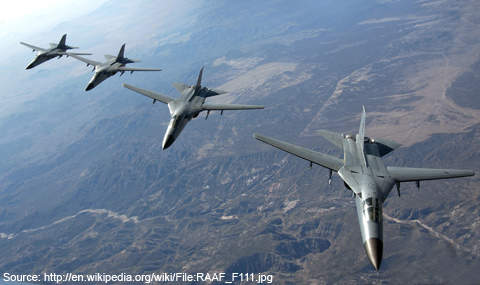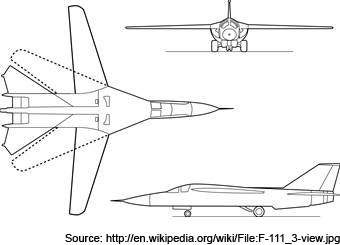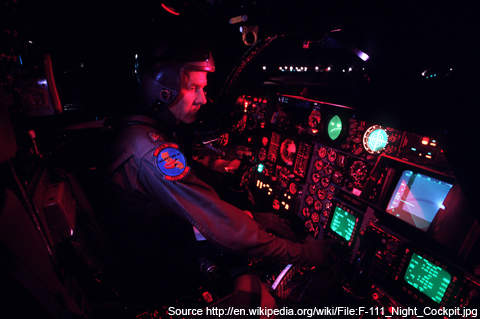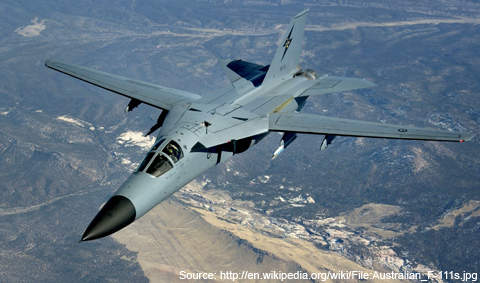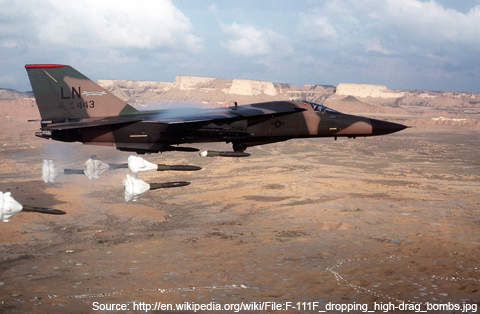The F-111 fighter, also called Aardvark, is a medium-range, multi-purpose tactical strike aircraft that was developed by General Dynamics. Previously known as TFX (Tactical Fighter "X"), the aircraft was developed in response to a joint services requirement for a superior fighter from the US Air Force (USAF) and US Navy in 1960. Several variants were developed for operations such as strategic bomber, electronic warfare and reconnaissance.
The F-111 aircraft conducted its first flight in December 1964 and entered into service with the USAF in 1967. Production of the F-111 was ceased in 1976 after building 566 aircraft in different versions. The variants of the F-111 were in service with the USAF until 1998.
The Australian F-111 variant was delivered in 1968. The aircraft first entered into the Royal Australian Air Force (RAAF) service in 1973. It was earlier delayed due to problems such as structural integrity and political issues. RAAF has been the sole operator of the F-111 with 21 aircraft. They will, however, be retired from service in December 2010. In 2007, the Australian Government decided to replace the F-111 aircraft of RAAF with 24 F/A-18F Super Hornets.
Tactical Fighter Experimental (TFX) programme
The F-111 was developed as part of the Tactical Fighter Experimental (TFX) programme during early 1960s. The programme was to develop, consolidate and meet the needs of a supersonic strike aircraft/ tactical fighter-bomber for the USAF and a long range interceptor for the US Navy. The aircraft with large long-range designs were based on swing-wing platform. They were developed with two-seat and twin-engine features. Both the USAF and US Navy aircraft versions were similar in design and could carry large warloads at high speeds.
In 1961 a request for proposals (RFP) was called to develop the aircraft based on the TFX specifically designed for USAF. The General Dynamics designs were selected against the competitors, including Lockheed Martin and Boeing followed, by the TFX contract in December 1962. The General Dynamics proposal had similar structural components for both the USAF and US Navy aircraft versions, while Boeing designs lacked this commonality.
F-111 ‘Aardvark’ fighter jet design
The F-111 was given the name Aardvark due to its long and slightly overturned nose. The F-111’s design features variable geometry wings and is mostly built with aluminium, titanium steel. It has an internal weapons bay and a cockpit with side-by-side seating in escape crew capsule.
The aircraft is capable of attacking in all-weather conditions and delivering ordnance through low-level penetration of enemy defences. The wing span in full forward and full sweep varies from 16° to 72.5°. The fuselage is made of honeycomb sandwich and stiffened panels, making it a semi-monocoque structure. The F-111 is powered by two Pratt & Whitney TF30 afterburning turbofan engines. The F-111 variants include a terrain-following radar system. General Dynamics collaborated with Northrop Grumman for designing the fuselage, landing gear and assembly and test of the aircraft.
F-111A and F-111B mission variants
Two F-111 variants, F-111A and F-111B were initially developed for the USAF and US Navy respectively. They were built with same airframe structural components and were powered by TF30-P-1 turbofan engines. The USAF F-111A carried AN/APQ-110 terrain-following radar, AN/APQ-113 attack radar and air-to-ground armament. Of the total 158 F-111As produced, 42 were converted to EF-111A Ravens and others were retired from the USAF in 1989 and mothballed at Aerospace Maintenance and Regeneration Center.
The nose of F-111B was 2.59m shorter than the first variant and featured 1.07m longer wingtips. The design allowed the carrier to equip elevator decks, and also improve the on-station endurance time. The F-111B could carry six AIM-54 Phoenix missiles and an AN/AWG-9 Pulse-Doppler radar. The US Navy, however, did not accept the F-111B due to its performance and weight issues.
The variant F-111C was developed with improved wings and landing gear for export to Australia. RAAF ordered 24 aircraft in 1963. Though the first aircraft was delivered in 1968, there were development delays and structural problems.
In 1979-80, four F-111C were modified to reconnaissance configuration (RF-111C). Starting from 1994, F-111C and RF-111C underwent a TF30-P-109 engine upgrade with each engine having 93kN thrust. F-111C was upgraded to digital avionics in 1998.
The other improved variants developed for the USAF were F-111D, F-111E, F-111F and FB-111A. F-111D was an F-111A equipped with Mark II avionics, improved intake geometry, powerful engines and glass cockpit. F-111E was an interim variant, developed as a result of delays in the F-111D building. It had the same Mark I avionics and the TF30-P-3 but with Triple Plow II intakes.
The final variant F-111F was a Tactical Air Command aircraft using Mark IIB avionics system. It used an improved wing carry through box and Triple Plow II intakes with TF30-P-100 turbofan engines having 112kN afterburning thrust. The engines were subsequently upgraded to TF30-P-109.
The FB-111A was a strategic bomber variant developed for the USAF Strategic Air Command. It had increased load-carrying capacity and range and used SAC Mark IIB avionics suite. It had Triple Plow II intakes and TF30-P-7 engine. The main armament of FB-111A was Boeing AGM-69 short-range attack missile. In 1972, 42 existing F-111As were converted to electronic warfare version, EF-111A Raven by Northrop Grumman. They were retired from USAF service in May 1998.
Armament
The F-111 fighter is armed with air-to-surface ordnance for the long-range attack. The internal weapons bay under the fuselage could include various weapons. The tactical combat variants, excluding the EF-111A or FB-111A/F-111G, could carry a M61 Vulcan 20mm cannon with a 2,084 round ammunition tank. It was, however, never used in any combat and was removed from the aircraft by the early 1980s.
The internal bay could carry Mk 117 type (340kg) bombs and up to Mk 118 (1,400kg) was cleared. The F-111 could carry various free-fall nuclear weapons such as B43, B57 and B61 bombs. The F-111 could not carry any external weapons due to its fuselage design. The F-111C can launch AGM-142 Popeye stand-off missile, AGM-84 Harpoon anti-ship missile and AGM-88 HARM anti-radiation missile.
Countermeasures / sensors
The variants F-111C and F-111F could carry the AN/AVQ-26 Pave Tack targeting system sensor pod equipped on a rotating carriage. The rangefinder/designator and forward looking infrared (FLIR) of the Pave Tack allowed the aircraft to drop laser-guided bombs on designated targets. The Australian RF-111C also carries a reconnaissance pallet with KA-93A4 high-altitude panoramic cameras, Honeywell AN/AAD-5 infrared linescan, a Fairchild KA-56E low-altitude, two CAI KS-87C split vertical cameras and video cameras.

